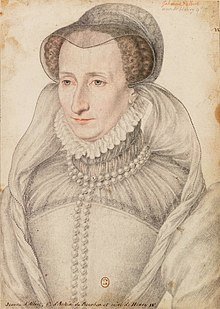Jeanne d'Albret
| Jeanne III | |
|---|---|
 Jeanne III of Navarre painted byFrançois Clouet,1570 | |
| Queen of Navarre | |
| Reign | 25 May 1555 – 9 June 1572 |
| Coronation | 18 August 1555 atPau |
| Predecessor | Henry II |
| Successor | Henry III |
| Born | 7 January 1528 Pau,France |
| Died | 9 June 1572(aged 44) Paris |
| Burial | Ducal Church of collégiale Saint-Georges,Vendôme |
| Spouse | William, Duke of Jülich-Cleves-Berg Antoine, King of Navarre |
| Issue | Henry IV, King of France Catherine de Bourbon,Hereditary Princess ofLorraine |
| House | House of Albret |
| Father | Henry II, King of Navarre |
| Mother | Marguerite de Navarre |
| Religion | Huguenot |
Jeanne d'Albret(7 January 1528 – 9 June 1572), also known asJeanne III d'AlbretorJoan III,was thequeen regnantof theKingdom of Navarrefrom 1555 to 1572.
Her second marriage toAntoine de Bourbon,Duke ofVendôme,produced her son,Henry of Bourbon.Henry became King Henry III of Navarre and King Henry IV of France, the firstBourbonking of France. She became theDuchess of Vendômeby that marriage.
Jeanne was the acknowledged spiritual and political leader of theFrench Huguenotmovement,[1]and a key figure in theFrench Wars of Religion.
First marriage
[change|change source]As a girl, she had a remarkably strong character. Her parents wanted her to marry William "the Rich", Duke of Jülich-Cleves-Berg. He was the brother ofAnne of Cleves,the fourth wife ofHenry VIII of England.She was 12 or 13 at the time, quite normal then for a girl's marriage.
She refused, and her mother had herwhipped.[2]The whipping was extremely severe,[3]but the girl continued to resist the marriage. Finally, she was carried bodily to thealtarby theConstable of France,and married against her will.
Evidently she still continued her resistance, because the marriage was eventuallyannulledon the grounds of non-consummation.[4]
Second marriage
[change|change source]Her second marriage was also a political marriage. Its intent was to unify territory in the south and north of France. However, this time there was love involved.[1]Acontemporarywrote "she had no pleasure or occupation except in talking about or writing to [her husband]. She does it in company and in private... the waters cannot quench the flame of her love".[1]
The couple had five children, two of whom survived to adult life.
Queen of Navarre
[change|change source]
On 25 May 1555, Henry II of Navarre died, at which time Jeanne and her husband became joint rulers of Navarre. Jeanne and Antoine were crowned in a joint ceremony according to the rites of the Roman Catholic Church on 18 August 1555 atPau.[5]
Jeanne's husband died on 17 November 1562, so for the last ten years of her life she was the sole ruler of Navarre.
Religion
[change|change source]During Jeanne's life, religion in France was a battleground between theCatholic churchand theProtestantCalvinismof theHuguenots.
In religion Jeanne was influenced by her mother,[5]towards religiousreform,humanistthinking, and individualliberty.Jeanne converted toCalvinismon Christmas Day 1560. This conversion made her the highest-ranking Protestant in France.[6]
Following the imposition of Calvinism in her kingdom,priestsandnunswere banished, Catholic churches destroyed, and Catholic ritual prohibited.[1]She commissioned the translation of theNew TestamentintoBasqueandBéarnesefor the benefit of her subjects.
She was described as "small of stature, frail but erect". She was highly intelligent, but austere and self-righteous.Agrippa d' Aubigné,the Huguenot chronicler, described Jeanne as having "a mind powerful enough to guide the highest affairs".[1]
In addition to her religious reforms, Jeanne worked on reorganising her kingdom; making long-lasting reforms to the economic and judicial systems of her domains.[7]
Jeanne died inParisfrom afever(probably aninfectious disease) at the age of 44.
References
[change|change source]- ↑1.01.11.21.31.4Strage, Mark 1976.Women of Power: the life and times of Catherine de' Medici.New York and London: Harcourt Brace Jovanovich, p143/150.ISBN0-15-198370-4
- ↑Robin, Diana Maury; Larsen, Anne R.; Levin, Carole 2007.Encyclopedia of women in the Renaissance: Italy, France, and England.ABC-CLIO, p3.
- ↑Havelock Ellis 1927.Studies in the Psychology of Sex,volume 3.
- ↑Means sexual intercourse had not taken place.
- ↑5.05.1Bryson, David 1999.Queen Jeanne and the Promised Land: dynasty, homeland, religion, and violence in sixteenth-century France,p75.
- ↑Roelker 1968. Roelker, Nancy Lyman 1968.Queen of Navarre, Jeanne d'Albret: 1528–1572.Harvard University Press, p154.ISBN0-674-74150-1
- ↑Roelker 1968, p210.
